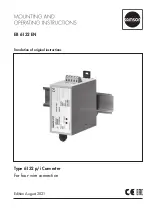
OPERATION
Page
82
Copyright
Trace Engineering Company, Inc.
5916 - 195th Street N. E.
Arlington, WA 98223
Telephone: 360/435-8826
Fax: 360/435-2229
www.traceengineering.com
SW Series Inverter/Charger
Part No. 2031-5
Rev. B: Sept 1, 1999
UTILITY SUPPORT/OVERLOAD PROTECTION
This battery charger is very powerful and without limits could draw more current than is available from the
AC input source. When the utility grid is available, the grid has to power both the battery charger and any
AC loads connected. If AC charge current combined with any AC load current exceeds the GRID (AC1)
AMPS AC menu item setting, the charge rate will be automatically reduced to keep from tripping the utility
grid breaker.
In addition, the inverter will support utility grid in the event that excessive loads threaten to trip the AC
breaker. If the amount of power demanded by the AC loads is greater than the GRID (AC1) AMPS AC
menu item setting, the inverter will contribute power to operate the AC loads. This will limit the AC current
drawn from the utility system.
This ability allows the utility line to be sized closer to the typical draw of the system, instead of being sized
to the maximum load. This may save considerable cost if a utility extension or upgrade is being installed.
The savings can even offset part or all of the inverter / battery system in some situations.
While the inverter is supporting the AC loads, the battery will be discharging. Typically, utility line support is
required for only short period of time during heavy power usage that will not cause the battery to be
significantly drained.
USING SLT MODE (SILENT MODE)
In SLT mode the batteries are charged only once a day, at a time prescribed in the BULK CHARGE
TRIGGER TIMER (15) menu heading. Selecting SLT in the SET GRID USAGE menu item, located under
the INVERTER SETUP (9) menu heading enables it. During the rest of the day the battery charger is
turned off and the utility grid powers the AC loads. If a utility outage occurs, the inverter turns on and runs
the loads. When power returns, the inverter will return to the SLT mode after it has completed the Bulk
and Absorption stages of the battery charging process. The advantage of SLT mode is silent operation
and slightly less power consumption under most conditions and quieter operation since the battery charger
is off most of the time. The disadvantage of SLT mode is the loss of the natural power conditioning ability
of the inverter and the ability to “back off” the AC input which prevents overloading or circuit breaker
tripping (except during the time that the inverter is charging). The transition from utility to inverter when an
outage occurs may also be more noticeable.
When using this mode, a START BULK TIME must be entered from the BULK CHARGE TRIGGER
TIMER (15) menu heading. If the timer is defeated by setting it to 00:00, no bulk charging will take place
on a daily basis except immediately after a grid failure has occurred and the power has been restored.
The default setting is 00:00 that defeats the BULK CHARGE TRIGGER TIMER.
BATTERY REQUIREMENTS
Utility back-up applications usually are designed to discharge the battery at a higher rate for a shorter
duration than alternative energy applications. Typically, batteries capacity ratings are for discharge periods
of 20 hours. This means that a 100-amp hour battery can deliver 5 amp hours for 20 hours. It cannot
deliver 100 amp hours for 1 hour. Battery manufactures can provide de-rating curves for their products. If
the battery is not large enough, unsatisfactory performance may result. For the best performance,
oversizing of the battery is strongly recommended.
Summary of Contents for SW II - REV 4.01
Page 151: ......
















































